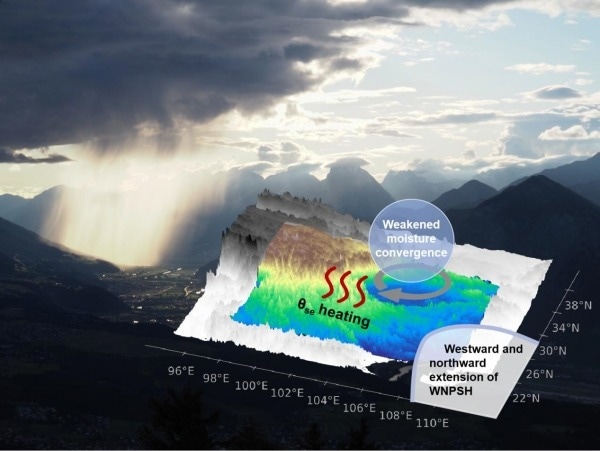Recent research led by Prof. Xiaopeng Cui from the Institute of Atmospheric Physics at the Chinese Academy of Sciences, in collaboration with experts from the National Meteorological Center of China, has revealed a concerning trend of heightened short-duration extreme precipitation in mountainous areas of Southwest China.

A new study unveils the forces behind extreme hourly precipitation shifts in Southwest China. Image Credit: The background image by Lauser and the diagram of mechanism by Rouyi Jiang
This discovery adds valuable insights into the urgent matter of climate change and its substantial influence on extreme weather events.
In a world contending with the repercussions of global warming, the research team's exploration exposes a troubling reality: although total global precipitation is on the rise, the intensification of short-duration extreme precipitation exceeds the overall increase. This trend is particularly pronounced in the intricate topography of Southwest China, which includes Sichuan, Chongqing, Yunnan, and Guizhou, where multiple climatic systems intersect.
The results of this investigation have been published in the Journal of Applied Meteorology and Climatology.
In warm seasons, heavy precipitation frequently plagues Southwest China, resulting in severe hydrological and geological disasters. Our study has uncovered a concerning trend of extreme hourly precipitation increasing in the region, a pattern that is more susceptible to global warming.
Xiaopeng Cui, Professor, Institute of Atmospheric Physics, Chinese Academy of Sciences
Covering the period from 1981 to 2020, the research investigates the spatiotemporal variations of extreme hourly precipitation events (EHPs) during warm seasons and explores the underlying mechanisms.
The findings reveal a troubling pattern, with EHPs experiencing a more pronounced increase compared to total precipitation, especially in regions with terrain heights surpassing 500 m. Additionally, EHPs are predominantly concentrated between June and August, showcasing a bimodal structure in diurnal variation.
The study identifies that EHPs are frequently associated with anomalous changes in circulation, characterized by positive anomalies in pseudo-equivalent potential temperature, humidity, geopotential height, and anomalous cyclonic circulation in the low-level wind field.
The westward and northward extension of the western North Pacific subtropical high, coupled with the rise in pseudo-equivalent potential temperature, is considered a key factor driving the surge in EHPs.
The implications of this heightened occurrence are extensive, as short-duration extreme precipitation events have the potential to trigger flash floods and landslides, posing threats to lives and ecosystems, particularly in mountainous regions.
The characteristics, changes, mechanisms, and predictions of short-duration extreme precipitation in mountainous areas require high attention.
Xiaopeng Cui, Professor, Institute of Atmospheric Physics, Chinese Academy of Sciences
This study is funded by the Strategic Priority Research Program of the Chinese Academy of Sciences.
Journal Reference
Jiang, R., et al. (2023). A 40-year statistics of warm-season extreme hourly precipitation over Southwest China. AMS. doi.org/10.1175/JAMC-D-23-0018.1